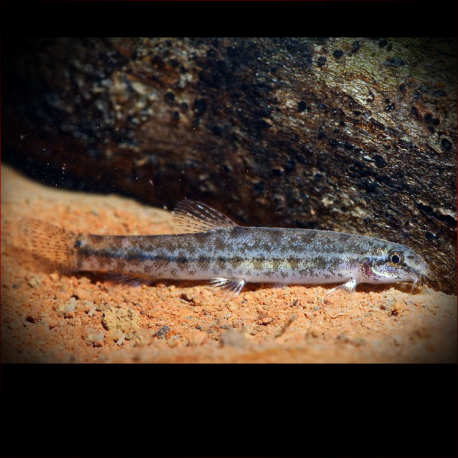More info
Datasheet
| Minimum Tank Size | 60 litres / 15.85 US gallons |
| Maximum Size | 6.0cm / 2.36inches |
| Temperature | 23°C / 73.40°F - 26°C / 78.80°F |
| Hardness | 2.02dgH / 36ppm - 10.03dgH / 179ppm |
| pH | 5.5-7.5 |
General Description
Lepidocephalichthys hasselti, commonly known as Hasselt's loach, is a peaceful fish species belonging to the family Cobitidae within the order Cypriniformes. Widely distributed and relatively common in the aquarium trade, this species is distinguishable by its unique physical characteristics, including a truncate caudal fin, scaleless patch on the head, and irregular spotted patterning on the flanks. This species possesses sharp, motile, sub-ocular spines that can pose a risk when the fish is stressed.
Aquarium Setup
Creating a suitable habitat for L. hasselti involves providing a soft, sandy substrate to accommodate its burrowing behavior, as coarser gravel may stress the fish. Decorate the tank with water-worn rocks, driftwood branches, and tree roots to offer hiding spots and shaded areas. It's advisable to maintain dim lighting unless growing plants, supplementing with leaf litter for a natural aesthetic. Given their preference for sluggish waters, high flow rates should be avoided, although some oxygenation is recommended. Ensure small specimens cannot access filter intakes and secure the tank as these loaches may jump, especially when acclimating.
Behaviour
Lepidocephalichthys hasselti exhibit peaceful behavior with conspecifics and other tankmates, making them suitable for community tanks. When kept in groups of four or more, these loaches tend to thrive. Their companions should ideally include fish from similar environments that occupy the upper water column, as this can help reduce timidity. Other sand-dwelling loaches from compatible families can also coexist, though caution is advised due to potential territorial or aggressive behavior.
Feeding and Diet
As micropredators, L. hasselti sifts mouthfuls of substrate to extract insect larvae and small crustaceans. In captivity, they accept sinking dried foods but thrive on a diet rich in small live and frozen fare such as Daphnia, Artemia, and bloodworms. Providing a varied diet ensures the nutritional needs of these fish are met.
Reproduction & Dimorphism
The reproductive behavior of Lepidocephalichthys hasselti in the wild is presumed to be seasonal; however, breeding in captivity remains unreported. Sexual dimorphism is visible in mature males, characterized by enlarged pectoral fins with a lamina circularis structure formed by fused innermost rays. Adult females are typically larger and heavier-bodied than males, displaying spotted flank patterning.
Habitat and Distribution
Natively found in shallow, slow-moving streams, swamps, oxbows, and paddy fields, L. hasselti is distributed across Southeast Asia, including regions in Indonesia, Myanmar, Thailand, Laos, Cambodia, Vietnam, Malaysia, Sumatra, and Borneo. Variations in coloration and patterns based on localities have posed challenges in species identification, resulting in the consolidation of some previously distinct species under L. hasselti. These fish have demonstrated adaptations to varying water conditions, including the ability to use their intestines for breathing during oxygen-depleted periods.

